![]()
![]()
![]()
Use LEFT and RIGHT arrow keys to navigate between flashcards;
Use UP and DOWN arrow keys to flip the card;
H to show hint;
A reads text to speech;
42 Cards in this Set
- Front
- Back
|
What are lab blanks and what is the purpose of them?
What is NIOSH's recommendation? |
Lab blanks (media blanks) are samples that have not been sent to the field.
Used for lab quality control. NIOSH recommends 6 media blanks from same sample lot as field samples. |
|
|
What are field blanks and what are they used for?
How many field blanks are recommended per 10 samples? |
Field blanks are sample media taken to the field, but they are not exposed.
Used for field sampling quality control. 2 per 10 samples with max of 10 field blanks. |
|
|
NIOSH recommends how many blanks sent to the lab with 16 field samples?
|
NIOSH recommends 4 field banks with the 16 field samples plus 6 media blanks.
|
|
|
What is the Limit of Detection (LOD) ?
|
LOD is the lowest concentration detected by laboratory instruments.
Generally 3x the instrument noise level (s/n >3) |
|
|
What is the Limit of Quantification (LOQ) ?
|
Lowest concentration quantifiable in the lab.
Generally 10x the instrument noise level (s/n >10) |
|
|
NIOSH rule of thumb for sampling statistics
|
at least 6 samples required for valid estimate of confidence interval around the mean.
>11 samples required to estimate variance. |
|
|
What is Gas Chromatography?
used frequently for ? limitation? |

GC is a process by which a mixture is separated (by boiling points) into its constitues by moving gas phase passing over a sorbent called a stationery phase.
Carrier gas such as He, Ar, N2, H2. Works with very small quantities Used frequently for hydrocarbons. Limitation - substance must exist in a gaseous or vapor state. |
|
|
High Performance Liquid Chromatography is similar to GC except for?
Contaminant must be ___ in mobile phase? Advantages? Used frequently for? |
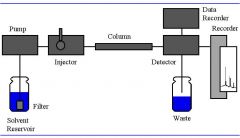
HPLC is similar to GC except for the carrier media is a liquid. Contaminant must be soluble in mobile phase. Advantages = speed, resolution, sensitivity
Used for PCBs, herbicides, insecticides, phthalates, isocyanates. HPLC uses liquid at high pressure as the mobile phase to sweep contaminants through a narrow column containing small sorbent particles. |
|
|
Ion Chromatography is a form of liquid chromatography that uses ________ to separate atomic or molecular ions based on their interactions with the resin.
Used for ? |
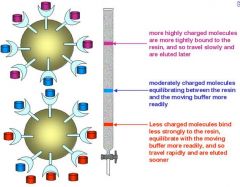
Ion Chromatography is a form of liquid chromatography that uses ion-exchange resins to separate atomic or molecular ions based on their interactions with the resin.
Used for anionic and cationic species, ions of alkali and alkaline earth metals, inorganic compounds and aldehydes. |
|
|
UV absorbance measures ?
Amt of light is____ to the _____ of absorbing material. Absorption follows _____ Law. |
UV absorbance measures amount of UV light absorbed by sample.
Amt of light is proportional to concentration of absorbing material. Absorption follows Beer-Lampert Law |
|
|
Fluorescence Detector measures?
Used for? How does it work? |
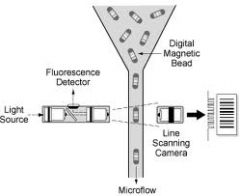
Fluoroscence detector measures light by fluorescing elements.
Highly conjugated aromatics, ie. PAHs. Naphthalene is the simplest example of a PAH. PAHs occur in oil, coal, and tar deposits, and are produced as byproducts of fuel burning (whether fossil fuel or biomass). Light source raises energy of electrons which decay emitting light at longer wave lengths. |
|
|
Mass Spectrometry is a technique of ?
Helpful for? Molecules are given an? Molecules are selected based on? |
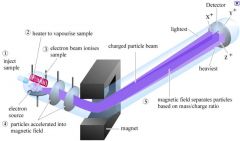
Mass spectrometry bombards molecules with an electron beam to seperate substance.
Helpful for identifying unknowns. Molecules are given a electric charge and are accelerated into an EMF field. The EMF field is varied. Moecules are selected based on their mass/charge (M/z) ratio. |
|
|
Atomic Emission Spectroscopy uses what to excite electrons?
What happens to the e- as they return to previous level? Used for what? |
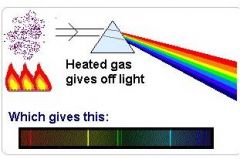
Atomic Emission Spectroscopy - electrons are excited to higher energy level by HEAT (5,000 -10,000 C).
Radiation (specific light wavelength) emitted by atoms, ions and molecular substances after excited by thermal energy. Used for trace elements. Less sensitive than AAS |
|
|
Atomic Absorption Spectroscopy
Electrons are excited to a higher energy level using? what do the e- do? Used for ? Limited to ____ elements per analysis. |
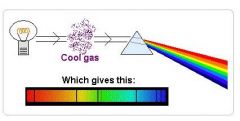
AAS
Electrons are excited to the next energy level by using LIGHT. e- absorbs specific light wavelengths. Used for trace elements. Limited to 5 or 6 elements per analysis. |
|
|
XRF
X-ray Fluorescence combines ____ and ____. Used to identify ? Used for what type of surveys? |

XRF combines atomic emission and atomic absorption.
Used to identify elements in solid and liquids. Portable instrument used for lead surveys. |
|
|
What is the best analytical method to detect herbicides in a sample?
|
HPLC
|
|
|
Which is the best analytical method to detect benzo(a)pyrene in a sample?
|
GC/MS
|
|
|
Which is the best analytical method to detect cadmium in a sample?
|
XRF
|
|
|
Which instrument would be most useful for surveying ammonia emissions in a 2 mile radius from a point source (smoke stack)?
A. Open path FTIR B. PID C. IR Thermometer D. Hot Wire Anemometer |
A. An open path FTIR is capable of reading emissions along a fence line or in open spaces.
|
|
|
What type of Gas Chromatography (GC) detector uses an ultraviolet (UV) lamp to ionize compounds such as organics and aromatics?
|
A PID is a photo ionization detector. It uses an ultraviolet light to ionize substances.
|
|
|
What type of Gas Chromatography (GC) detector uses a hydrogen flame to ionize compounds ?
|
An FID is a flame ionization detector. It uses a hydrogen flame to ionize substances.
|
|
|
Define ionization potential.
|
Ionization potential (IP) is the energy required to remove an electron from an atom or molecule. A photoionization detector (PID) uses an ultraviolet lamp to ionize molecules. The energy level of the lamp must be higher than the IP of the contaminant in order for the PID to detect the contaminant.
|
|
|
Which instrument may be used to measure oxygen concentrations?
A. FID B. PID C. GC/MS D. TCD |
A TCD is a thermal conductivity detector. It is used primarily for low molecular weight gases such as carbon monoxide, carbon dioxide, nitrogen, and oxygen.
|
|
|
What is the best method to analyze an air sample of aromatic hydrocarbons?
|
Gas chromatography
|
|
|
What method is most useful for analyzing contaminants with strong ions including acids and bases.
|
Ion chromatography
|
|
|
What type of detector pyrolizes (subject to very high temperatures) the contaminant in a hydrogen or air flame?
|
Flame ionization detector
|
|
|
In this analytical method, molecules of the sample are bombarded with ions or electrons. The collision results in the sample molecules being fragmented into a M/e ration.
|
Mass Spectrometry
|
|
|
Three types of chromatography?
Purpose? |
Gas Chromatography (GC)
High Performance Liquid Chromatography (HPLC) Ion Chromatography (IC) Purpose: Separation of components of a mixture. |
|
|
GC Analytical Data
Qualitative analysis measured by? Quantitative analysis measured by? |
GC Analytical Data
Qualitative analysis - retention time, depends on the experimental approach and the properties of the compound. Quantitative analysis- peak area, proportional to the concentration or quantity of the compound. |
|
|
Atomic absorption spectroscopy measures?
|
The about of energy absorbed by free atoms of the element of interest.
Flameless Flame |
|
|
Atomic emission spectroscopy measures?
|
Measures the enegery emitted by free atoms of the element of interest.
Flame Inductively Coupled Plasma (ICP) |
|
|
Inductively Coupled Plasma (ICP)
Samples are atomized with what? What happens as the excited atmos return to ground sate? What is measured and how does it correlate to concentration? |
Inductively Coupled Plasma (ICP)
Samples are atomized with an argon plasma at high temperatures (6000-8000 Kelvin) As the excited atoms return to the ground state, radiation of a characteristic wavelength is emitted. Emitted radiation is measured The intensity of the emitted radiation is directly proportional to the concentration of the atoms of interest. |
|
|
Accuracy
|
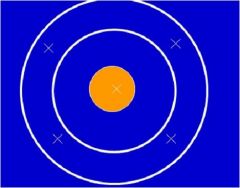
Closeness of measurements to the true value.
|
|
|
Precision
|
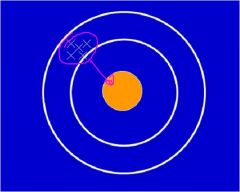
Reproducibility and repeatability
|
|
|
Cummalitve error
|
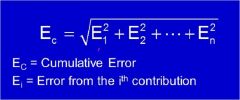
Error is associated with each step contributes to the overall error (uncertainty) associated with the final measure of exposure.
|
|
|
Lower Confidence Limit
|
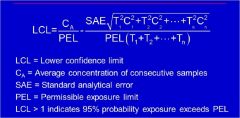
The lower limit is a statement of certainty about a mean value, specified at some level of confidence (95 or 99%).
LCL>1, exposure can be said to exceed PEL. |
|
|
What is used to collect aerosols?
How is mass calculated? |
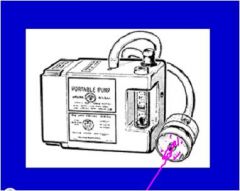
Pump and filter is used to collect aerosol.
Sample filter weighed and compared to pre-sampling weight. Mass of aerosol =difference in weights. |
|
|
What is the definition of a fiber ?
What methods are used to analyze for fibers? |

Fibers have an aspect ratio >3:1.
Methods: phase contrast microscopy (PCM) Polarized light microscopy (PLM) Electron microscopy Scanning electron microscopy (SEM) Transmission electron microscopy (TEM) |
|
|
Equation used to calculate fiber density.
Fiber density range: ? Count enough fields to yield _ fibers? Count at least _ fields, no more than _ fields? |
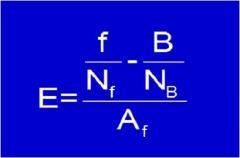
Fiber density: 100-1300 fibers/mm2
Count enough fields to yield 100 fibers. Count at least 20 fields, no more than 100 fields. |
|
|
Asbestos concentration
|

Eq
|
|
|
pH titration
|
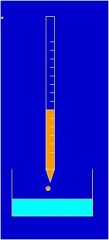
An indicator is added to an acid or base. A base or acid is slowly added to the solution until the indicator changes color.
The indicator changes color when the acid or base is neutralized. Calculate the normality of the solution using the known concentration of ions added to the base or acid. |
|
|
Beer-Lambert Law
|
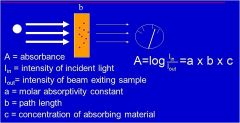
Light is absorbed
|

